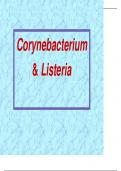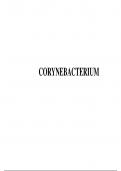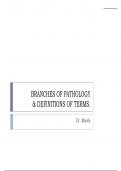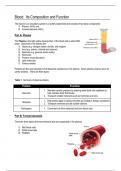exam questions with answer ,class notes
EXCELLENT HOMEWORK HELP AND TUTORING ,ALL KIND OF QUIZ AND EXAMS WITH GUARANTEE OF A
Am an expert on major courses especially; psychology,Nursing, Human resource Management and Mathemtics Assisting students with quality work is my first priority. I ensure scholarly standards in my documents and that's why i'm one of the BEST GOLD RATED TUTORS in STUVIA. I assure a GOOD GRADE if you will use my work.
- 203
- 0
- 1
Community
- Followers
- Following
201 items

Corynebacterium &Listeria
Pathogenic Anaerobic Gram-Positive Bacilli Corynebacteria (Genus Corynebacterium) Corynbacteria/”corynform bacteria” are non-spore forming, gram positive bacilli that tends to be clubbed or irregularly shaped (coryne=club). They are non-motile and it has a club shaped swelling at one or both ends, hence the name. Aerobic or facultatively anaerobic Small, pleomorphic (club-shaped), gram-positive bacilli that appear in short chains (“V” or “Y” confi...
- Class notes
- • 48 pages •
Pathogenic Anaerobic Gram-Positive Bacilli Corynebacteria (Genus Corynebacterium) Corynbacteria/”corynform bacteria” are non-spore forming, gram positive bacilli that tends to be clubbed or irregularly shaped (coryne=club). They are non-motile and it has a club shaped swelling at one or both ends, hence the name. Aerobic or facultatively anaerobic Small, pleomorphic (club-shaped), gram-positive bacilli that appear in short chains (“V” or “Y” confi...

CORYNEBACTERIA
CORYNEBACTERIA Morphology • Are gram positive bacilli • Have some swellings/ club shaped at the end • Polymorphic show variation in shape and size. Some are so short, others large • Stain irregularly due to the nature of their cell wall • They do not form spores • Do not have capsules, non motile • Facultative anaerobes • Several species Corynebacteria diphtheria This is the main pathogenic species in human • Collectively known as diptheroids or corynefor...
- Class notes
- • 15 pages •
CORYNEBACTERIA Morphology • Are gram positive bacilli • Have some swellings/ club shaped at the end • Polymorphic show variation in shape and size. Some are so short, others large • Stain irregularly due to the nature of their cell wall • They do not form spores • Do not have capsules, non motile • Facultative anaerobes • Several species Corynebacteria diphtheria This is the main pathogenic species in human • Collectively known as diptheroids or corynefor...

CROSS-MATCHING (Compatibility testing)
CROSS-MATCHING (Compatibility testing) This is a laboratory procedure to determine serological compatibility between a blood donor and an intended recipient before blood is transfused. Unknown serum is tested with known red cells in vitro to detect antibodies. Negative results are always taken to indicate compatibility while positive results indicate incompatibility. Types of cross-match. (1)Major cross-match In this procedure, the recipient serum is sampled against...
- Class notes
- • 5 pages •
CROSS-MATCHING (Compatibility testing) This is a laboratory procedure to determine serological compatibility between a blood donor and an intended recipient before blood is transfused. Unknown serum is tested with known red cells in vitro to detect antibodies. Negative results are always taken to indicate compatibility while positive results indicate incompatibility. Types of cross-match. (1)Major cross-match In this procedure, the recipient serum is sampled against...

CT SCAN PATHOLOGY
CT SCAN PATHOLOGY Thursday, September 26, 2024 A.N MALIK, DEPARTMENT OF HUMAN ANATOMY, JKUAT. 2 Thursday, September 26, 2024 A.N MALIK, DEPARTMENT OF HUMAN ANATOMY, JKUAT. 3 Thursday, September 26, 2024 A.N MALIK, DEPARTMENT OF HUMAN ANATOMY, JK
- Class notes
- • 20 pages •
CT SCAN PATHOLOGY Thursday, September 26, 2024 A.N MALIK, DEPARTMENT OF HUMAN ANATOMY, JKUAT. 2 Thursday, September 26, 2024 A.N MALIK, DEPARTMENT OF HUMAN ANATOMY, JKUAT. 3 Thursday, September 26, 2024 A.N MALIK, DEPARTMENT OF HUMAN ANATOMY, JK

CELL PHYSIOLOGY
CELL PHYSIOLOGY
- Class notes
- • 330 pages •

BREECH DELIVERY
BREECH DELIVERY FIRST STAGE OF LABOUR: VAGINAL BREECH AT TERM involves a longitudinal lie of the fetus, with the buttocks in the lower pole of the maternal uterus. The presenting diameter is the bitrochanteric (10 cm) and the denominator is the sacrum. As pregnancy progresses, the incidence of breech presentation reduces: being around 15% at 28–32 weeks to around 3–4% by term as a result of spontaneous version (MIDIRS 2008b). It is worth considering, th...
- Class notes
- • 55 pages •
BREECH DELIVERY FIRST STAGE OF LABOUR: VAGINAL BREECH AT TERM involves a longitudinal lie of the fetus, with the buttocks in the lower pole of the maternal uterus. The presenting diameter is the bitrochanteric (10 cm) and the denominator is the sacrum. As pregnancy progresses, the incidence of breech presentation reduces: being around 15% at 28–32 weeks to around 3–4% by term as a result of spontaneous version (MIDIRS 2008b). It is worth considering, th...

BRANCHES OF PATHOLOGY & DEFINITIONS OF TERMS.
BRANCHES OF PATHOLOGY & DEFINITIONS OF TERMS. Dr. Mwale There are two main branches of pathology: 1) General pathology: Focuses on the fundamental cellular and tissue responses to pathological stimuli. Eg inflammation, tumours or degenerations. 2) Systemic pathology: The descriptions of specific diseases as they affect individual organs or organ systems eg appendicitis, lung cancer and atheroma. Subdivisions of pathology Gross pathology: aka macroscopic pathology, ...
- Class notes
- • 5 pages •
BRANCHES OF PATHOLOGY & DEFINITIONS OF TERMS. Dr. Mwale There are two main branches of pathology: 1) General pathology: Focuses on the fundamental cellular and tissue responses to pathological stimuli. Eg inflammation, tumours or degenerations. 2) Systemic pathology: The descriptions of specific diseases as they affect individual organs or organ systems eg appendicitis, lung cancer and atheroma. Subdivisions of pathology Gross pathology: aka macroscopic pathology, ...

BRAIN STEM
Function and external structural organization 2 Comprises the midbrain, pons and medulla. Functions 1. Control of respiration 2. Control of the cardiovascular system 3. Partial control of gastrointestinal function 4. Control of many stereotyped movements of the body 5. Control of equilibrium 6. Control of eye movements 7. Conduit for fibers from higher centers 9/26/2024 A.N Malik, Department of Human Anatomy, JKUAT. Ventral view of the brain stem, in relation to cerebr...
- Class notes
- • 15 pages •
Function and external structural organization 2 Comprises the midbrain, pons and medulla. Functions 1. Control of respiration 2. Control of the cardiovascular system 3. Partial control of gastrointestinal function 4. Control of many stereotyped movements of the body 5. Control of equilibrium 6. Control of eye movements 7. Conduit for fibers from higher centers 9/26/2024 A.N Malik, Department of Human Anatomy, JKUAT. Ventral view of the brain stem, in relation to cerebr...

BLT4A Fundamentals of Taxation Exam 2024/2025 Latest Test Questions With Verified Solutions
BLT4A Fundamentals of Taxation Exam 2024/2025 Latest Test Questions With Verified Solutions Power of taxation is legislative in nature. Therefore, the power to tax may not be delegated, except a. To local government units or political subdivisions. b. None of the above. c. When allowed by the Constitution. d. When delegation relates merely to administrative implementation that may call for some degree of discretionary powers under a set of sufficient standa...
- Exam (elaborations)
- • 17 pages •
BLT4A Fundamentals of Taxation Exam 2024/2025 Latest Test Questions With Verified Solutions Power of taxation is legislative in nature. Therefore, the power to tax may not be delegated, except a. To local government units or political subdivisions. b. None of the above. c. When allowed by the Constitution. d. When delegation relates merely to administrative implementation that may call for some degree of discretionary powers under a set of sufficient standa...

blood_-_composition_anf_function
Blood: Its Composition and Function The blood in our circulatory system is a watery based fluid and consists of two basic components: 1) Plasma (55%) and, 2) Formed elements (45%) Part A: Plasma The Plasma is the light yellow liquid portion of the blood and is about 90% water. Dissolved in the plasma are: 1) Gases (e.g. nitrogen carbon dioxide, and oxygen) 2) Ions (e.g. sodium, chloride and calcium) 3) Nutrients (e.g. glucose, amino acids) 4) Hormones 5) Proteins (most ...
- Class notes
- • 4 pages •
Blood: Its Composition and Function The blood in our circulatory system is a watery based fluid and consists of two basic components: 1) Plasma (55%) and, 2) Formed elements (45%) Part A: Plasma The Plasma is the light yellow liquid portion of the blood and is about 90% water. Dissolved in the plasma are: 1) Gases (e.g. nitrogen carbon dioxide, and oxygen) 2) Ions (e.g. sodium, chloride and calcium) 3) Nutrients (e.g. glucose, amino acids) 4) Hormones 5) Proteins (most ...
